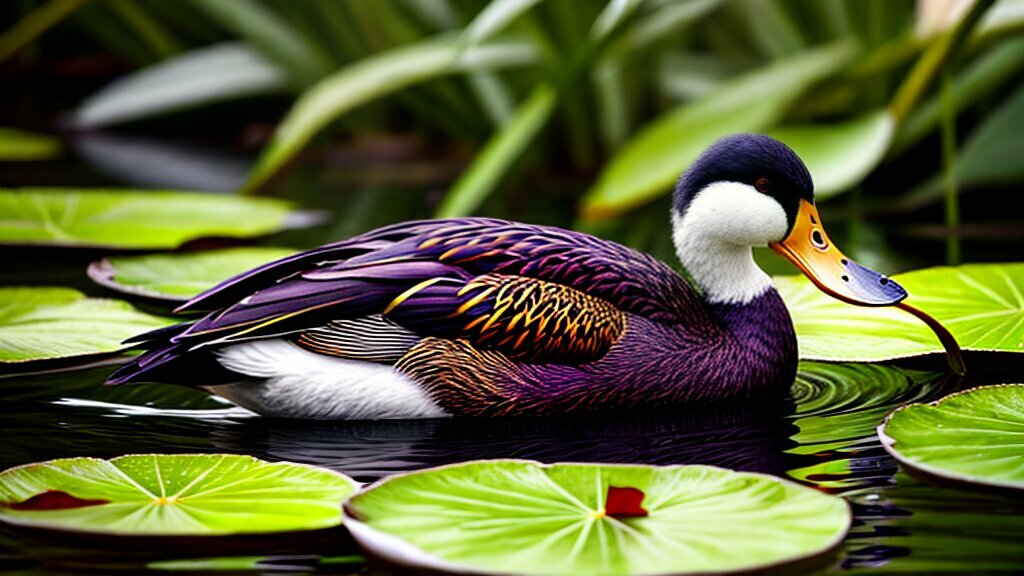Do Ducks Eat Lily Pads?

Table of content:
Lily pads are a common sight in ponds and lakes across North America. Their large green leaves and beautiful flowers make them aesthetically pleasing additions to local waterways. These aquatic plants provide habitat and food for fish, frogs, insects and other wildlife that dwell in freshwater ecosystems.
You may have noticed groups of ducks diving and dabbling around lily pad covered ponds. This raises the question – do ducks eat lily pads? Read on to find out.
Ducks and Their Diets
Ducks belong to the family Anatidae which includes swans, geese and other waterfowl species. There are around 140 species of ducks found worldwide. Most breeds of duck thrive around bodies of fresh water like lakes, rivers, streams and ponds.
Ducks have varied omnivorous diets consisting of aquatic plants, grasses, seeds, green vegetation, insects, worms, small fish, mollusks and crustaceans. The specific diet depends on the particular duck species and habitat.
Mallard ducks are among the most common duck species often seen foraging in ponds and marshes. Mallards are considered dabbling ducks – they feed mainly on or near the surface of water as opposed to diving for food. They use their broad bills to skim the water’s surface for tasty morsels like algae, weeds, grasses, aquatic plants and small invertebrates.
Diving ducks like scaups, canvasbacks and pochards dive deep underwater to search for food. Their diets consist more of insects, crustaceans, mollusks and vegetation. Mergansers are fish-eating ducks with narrow serrated bills adept at catching small fish and other aquatic animals.
Lily Pads – An Aquatic Habitat
Lily pads are aquatic flowering plants that float on the surface of still ponds, marshes, lakes and slow moving streams. They are rooted in soil below the water. The large circular leaves may grow up to 2 feet in diameter. The leaves have a waxy coating that repels water.
Lily pads thrive in freshwater habitats across most of North America. Common native species include American lotus (Nelumbo lutea), yellow pond lilies (Nuphar advena) and fragrant water lilies (Nymphaea odorata). These hardy plants spread rapidly via underwater tubers, rhizomes and seeds.
Lily pad beds create shade, shelter and breeding grounds for all sorts of aquatic life ranging from frogs to fish. Beneath the lily pads is a whole busy ecosystem of insects, snails, worms and larvae. Waterfowl often build nests and search for food among the floating discs.
Do Ducks Really Consume Lily Pads?
Now back to the original question – do ducks eat lily pads? The short answer is yes, ducks do nibble on certain parts of living lily pads. However, they are not a primary food source.
Lily pads are not a staple of duck diets. But ducks do supplement their diets by munching on tender new lily pad shoots, leaves, flower buds, seeds and roots. This grazing causes minimal damage to the plants.
Mallard ducks, in particular, regularly snack on lily pad pieces as they dabble and forage near the shore. The ducks will pluck tender new leaves, slit the leaves with their bills, peel back pieces and eat the soft internal leaf tissues.
Canvasback ducks feed on the rhizomes and tubers on the underside of lily pads. Mandarin ducks and wood ducks nibble on fresh lily pad leaves and seeds when available. Diving ducks snack on lily pad roots and tubers that they find underwater. Nutrients obtained from fresh aquatic plants provide protein and carbohydrates for ducks.
During nesting season, female ducks may increasingly graze upon aquatic plants to get more protein and calcium needed for egg production. This is when nibbling on lily pads may become more frequent.
Benefits of Ducks Eating Lily Pads
Ducks feeding on lily pads provides some benefits for the health of ponds and wetlands. As ducks forage, they uproot and stir sediment releasing nutrients. Their droppings also fertilize the water.
Plus, thinning out excessive lily pad growth allows sunlight to filter down to sustain a diversity of aquatic plant species. Their grazing decreases density of rapidly spreading pads so hundreds don’t completely cover the pond surface. This creates healthier habitats for fish, frogs and other creatures.
On the flip side, over foraging by large waterfowl populations can negatively impact lily pad density and aquatic ecosystems. Most suburban ponds have balanced duck numbers where predation on plants stays modest.
Final Thoughts
Dabbling ducks like mallards do regularly eat small amounts of lily pad leaves, stems, flowers and seeds as they forage in ponds and wetlands. Lily pads provide ducks with some supplemental nutrition and protein. But aquatic plants are not the mainstay of duck diets.
Watching ducks drift through lily pad beds, pecking and nibbling, can be entertaining. Their presence among the iconic pond flowers creates great nature photo opportunities.
So next time you observe ducks cruising around your favorite lily pond, you’ll know they enjoy snacking lightly on those broad floating lily leaves! Just don’t expect the pad bed to be completely devoured. The ducks cause minimal damage as they forage.
Welcome. I’m Adreena Shanum, the proud owner of this website, and I am incredibly passionate about animals, especially poultry. I founded adreenapets.com as a labor of love, stemming from my desire to share my knowledge and experiences with poultry enthusiasts worldwide.




